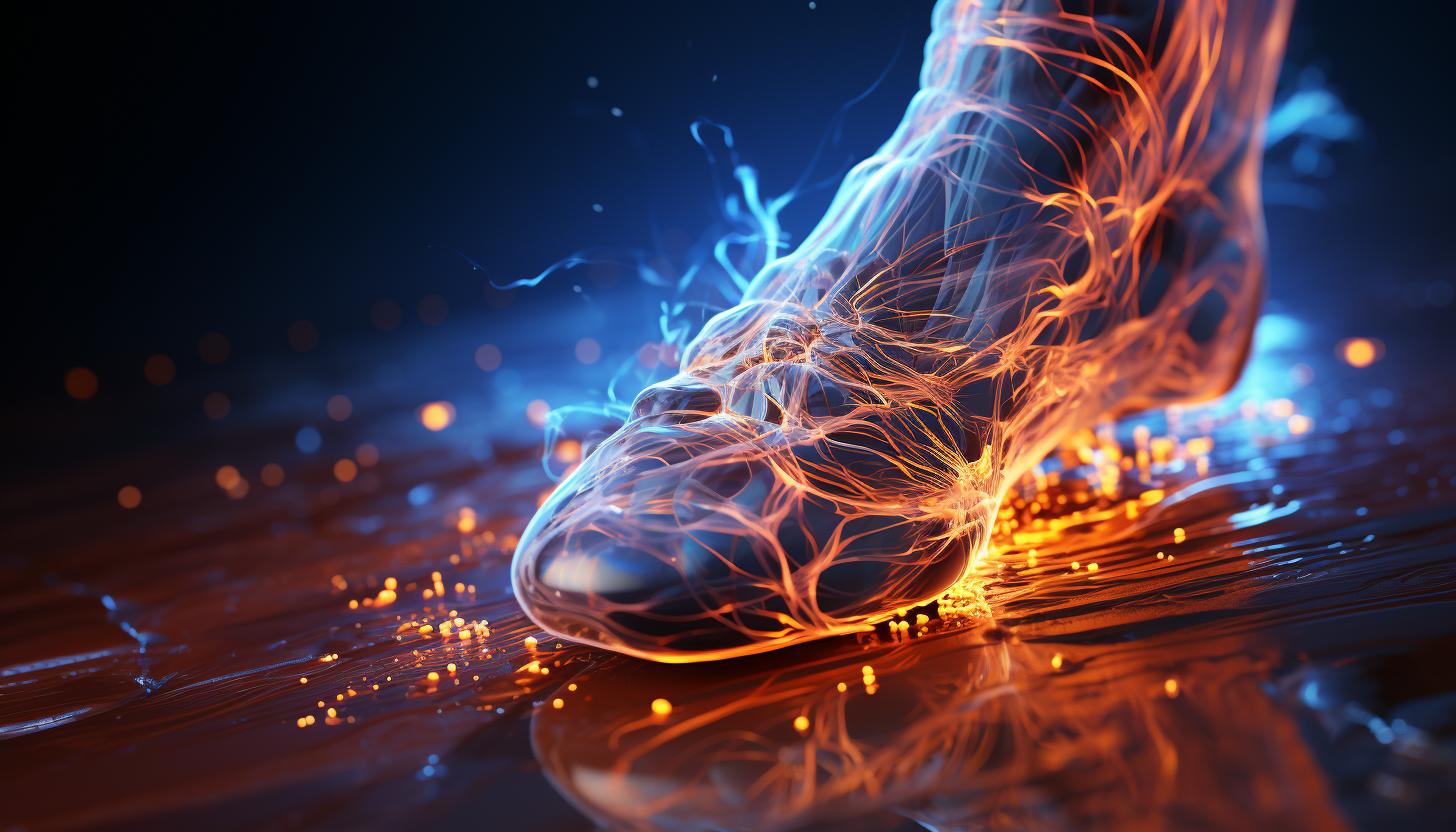Common Running Injuries: Causes, Symptoms, and Treatment

Are you tired of feeling like running is a constant battle against injury? Well, get ready to conquer those common running injuries once and for all!
In this article, we’ll dive into the causes, symptoms, and treatment options for ankle injuries, knee injuries, shin splints, plantar fasciitis, and IT band syndrome.
Get ready to lace up your shoes with confidence as we arm you with evidence-based knowledge to keep you on the track towards success.
Ankle Injuries

If you’re experiencing pain or swelling in your ankle, it might be a sign of an ankle injury. Two common types of ankle injuries are ankle sprains and Achilles tendonitis.
Ankle sprains occur when the ligaments that support the ankle joint become stretched or torn, usually due to sudden twisting or rolling movements. This can result in pain, swelling, and difficulty walking.
On the other hand, Achilles tendonitis is inflammation of the Achilles tendon, which connects the calf muscles to the heel bone. It is often caused by overuse or repetitive stress on the tendon, such as excessive running or jumping. Symptoms include pain at the back of the heel that worsens with activity and stiffness in the morning.
To treat ankle sprains, it is important to rest and protect your injured ankle by using crutches if necessary and wearing a brace or wrap for support. Applying ice packs and elevating your foot can help reduce swelling. Physical therapy exercises may also be recommended to improve strength and stability in your ankle.
For Achilles tendonitis, initial treatment involves resting from activities that aggravate the condition and applying ice packs to reduce inflammation. Stretching exercises for calf muscles can help relieve tension on the tendon. If symptoms persist, non-steroidal anti-inflammatory drugs (NSAIDs) may be prescribed for pain relief.
It’s crucial to seek medical advice if you suspect an ankle injury as proper diagnosis and treatment are essential for recovery and preventing further damage.
Knee Injuries

To prevent knee injuries, make sure you properly warm up and stretch before your run. Knee injuries are common among runners and can be caused by a variety of factors such as overuse, improper form, or lack of strength in the surrounding muscles. Two common knee injuries that runners may experience are patellar tendinitis and meniscus tears.
Patellar tendinitis occurs when there is inflammation or irritation in the tendon that connects the kneecap to the shinbone. This condition often presents as pain just below the kneecap and can worsen with activities like running or jumping. To treat patellar tendinitis, it is important to rest, apply ice to reduce inflammation, and perform strengthening exercises for the quadriceps muscles.
Meniscus tears involve damage to the cartilage in the knee joint caused by sudden twisting or direct impact. Symptoms include pain, swelling, and difficulty moving the knee. Treatment options depend on the severity of the tear but may include rest, physical therapy exercises, or in some cases, surgery.
By taking preventive measures such as warming up properly before runs and incorporating strength training exercises into your routine, you can decrease your risk of developing these common knee injuries while enjoying your runs more safely.
| Common Knee Injuries | Causes | Treatment |
|---|---|---|
| Patellar Tendinitis | Overuse | Resting |
| Improper form | Applying ice | |
| Lack of muscle strength | Strengthening exercises | |
| Meniscus Tears | Sudden twisting | Resting |
| Direct impact | Physical therapy | |
| Surgery (in severe cases) |
Remember to always listen to your body and seek medical advice if you experience persistent knee pain or any other concerning symptoms during your running routine.
Shin Splints

Make sure you listen to your body and seek medical advice if you experience persistent pain in your shins or any other concerning symptoms during your runs. Shin splints, also known as medial tibial stress syndrome, are a common overuse injury among runners. They occur when the muscles and tendons surrounding the shin bone become inflamed due to repetitive stress.
Fortunately, there are steps you can take to prevent shin splints and rehabilitate them if they do occur.
To prevent shin splints:
– Gradually increase your running mileage and intensity to allow your body to adapt.
– Wear proper footwear that provides adequate support for your feet.
– Incorporate cross-training activities, such as swimming or cycling, into your routine to reduce impact on the shins.
If you do develop shin splints, there are several rehab exercises that can help alleviate pain and promote healing:
– Calf stretches: Stretching the calf muscles can relieve tension on the shins.
– Toe raises: Strengthening the muscles of the lower leg can help support the shins.
– Eccentric heel drops: This exercise involves lowering the heels off a step or ledge to target specific muscles involved in shin stability.
Plantar Fasciitis

Plantar fasciitis is a painful condition that involves inflammation of the plantar fascia, a thick band of tissue that runs along the bottom of your foot. It commonly affects runners and individuals who put excessive pressure on their feet. The primary cause of plantar fasciitis is repetitive strain or overuse, which can lead to micro-tears in the plantar fascia. Other contributing factors include tight calf muscles, high arches, flat feet, obesity, and wearing unsupportive footwear.
When it comes to effective treatments for plantar fasciitis, there are several options available. Resting and avoiding activities that aggravate the condition is crucial in allowing the inflamed tissue to heal. Applying ice packs or using anti-inflammatory medications can help reduce pain and inflammation. Physical therapy exercises focusing on stretching and strengthening the calves and foot muscles can also provide relief.
Wearing appropriate footwear with proper arch support and cushioning is essential for managing plantar fasciitis. Orthotic inserts or shoe inserts can be used to provide additional support and alleviate pressure on the affected area. Night splints may also be recommended to stretch the calf muscles and plantar fascia while you sleep.
In severe cases where conservative treatments fail to provide relief, more advanced interventions like corticosteroid injections or shockwave therapy may be considered. However, these methods should only be used under the guidance of a healthcare professional.
Remember that early intervention is key when it comes to treating plantar fasciitis effectively. By identifying the causes and implementing appropriate treatments promptly, you can minimize pain and get back on your feet sooner rather than later.
IT Band Syndrome

When dealing with IT Band Syndrome, it’s important to address the underlying biomechanical issues that may be contributing to the condition. This will not only help alleviate the pain and discomfort but also prevent further injury.
Here are some effective strategies for managing IT Band Syndrome:
– IT band stretching: Regularly stretching your IT band can help improve flexibility and reduce tightness in the area. Simple stretches such as standing cross-legged stretches or using a foam roller can be beneficial.
– IT band strengthening: Strengthening exercises targeting the hip muscles, particularly the glutes and abductors, can help stabilize the pelvis and reduce strain on the IT band. Exercises like clamshells, side leg lifts, and squats with resistance bands are great options.
– Proper footwear and running form: Wearing appropriate shoes that provide proper support and cushioning is crucial in preventing IT Band Syndrome. Additionally, focusing on maintaining good running form, such as avoiding overstriding and ensuring proper hip alignment, can minimize stress on the IT band.
Conclusion
In conclusion, as a runner, you’ve likely experienced your fair share of common running injuries. But don’t fret! By understanding the causes, symptoms, and treatment options for ankle injuries, knee injuries, shin splints, plantar fasciitis, and IT band syndrome, you can effectively address these issues head-on.
Remember to listen to your body and give it the rest it needs when necessary. With proper care and attention, you’ll be back on track in no time.
So lace up those shoes and hit the pavement with confidence!






